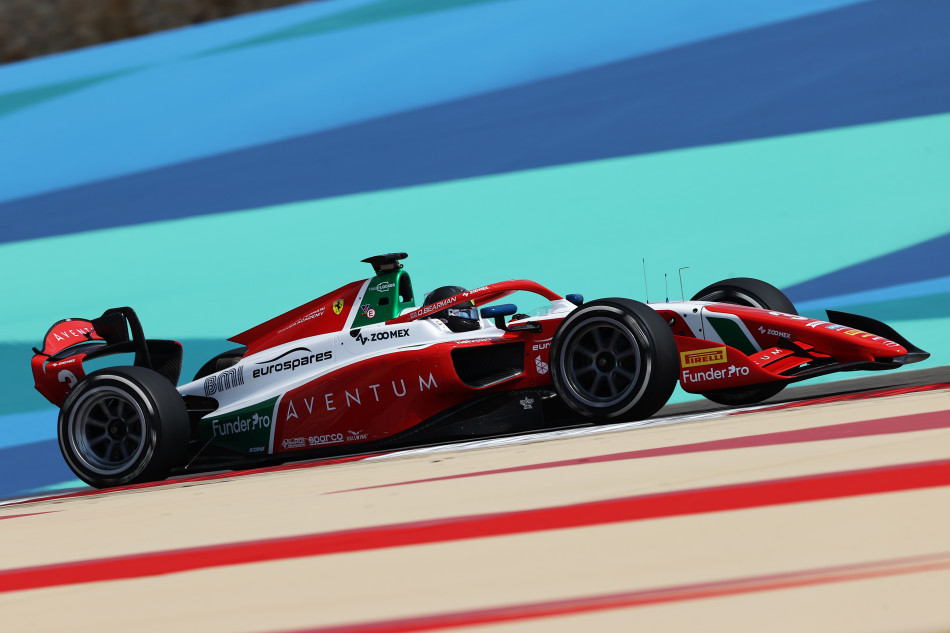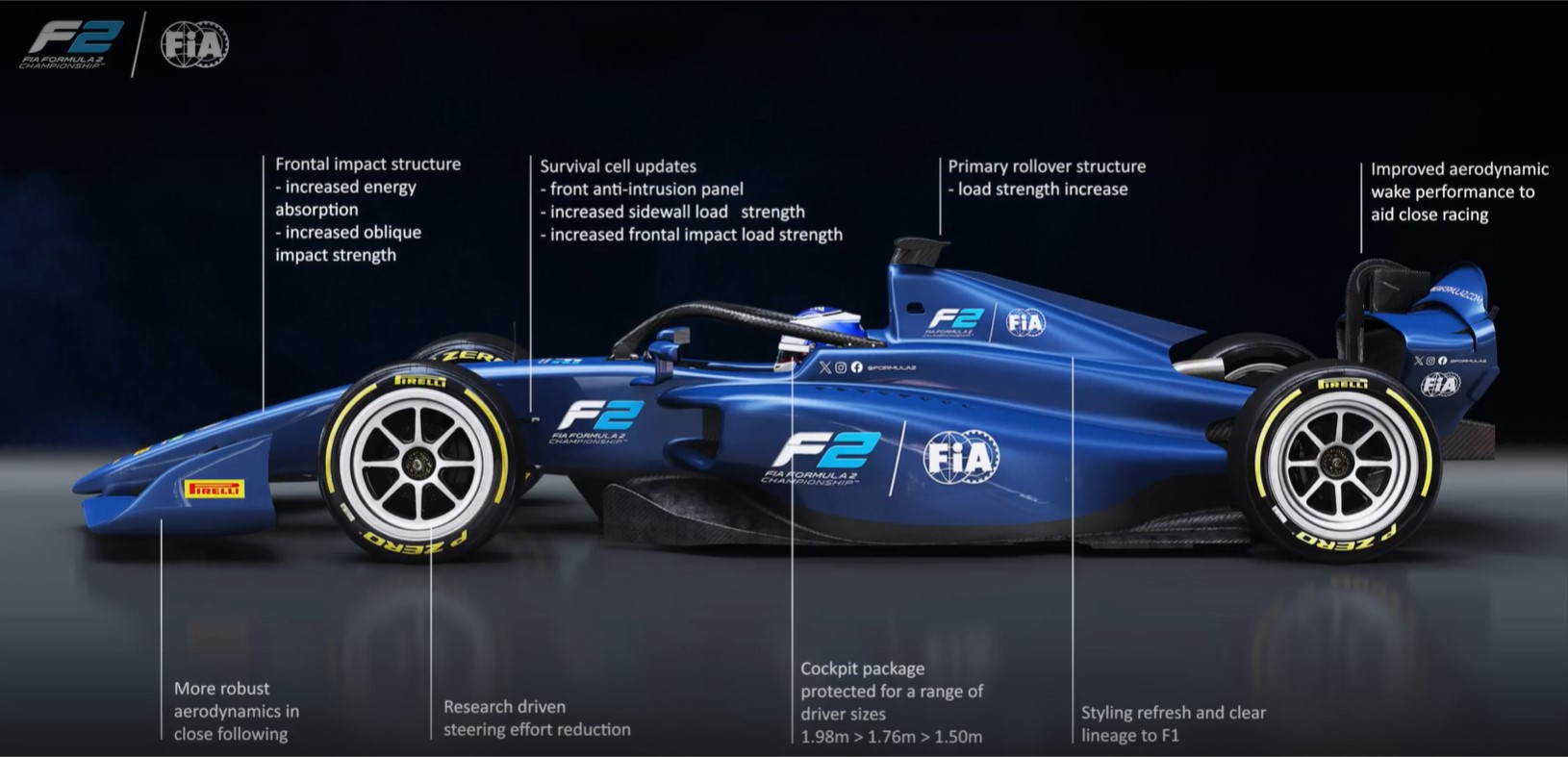Next gen F2: How the FIA made the new formula 2 cars safer, more sustainable and more accessible than ever
This weekend in Bahrain sees the competitive debut of an all-new FIA Formula 2 car. Taking lessons learned from F1 the FIA has worked to create a racier, more competitive car but also one that’s safer, more sustainable and more suited to a wider range of drivers – and all without sacrificing any performance. FIA Head of Technical: Single Seater Feeder Series Corrado Casiraghi explains how it has been achieved…

Q: The previous generation of F2 cars had raced since 2018, so what were the targets in the design of the new F2 2024?
Mainly to improve racing, to improve following in the same way F1 did and to adopt current safety standards, because the old generation had been around since 2018 and in the time since we have learned a lot. We focused on safety to a large degree and the updates are significant. In addition we want to look at accessibility, making the car driveable for a much wider range of competitors and also sustainability and finally, there is also a visual update, making it closer in style to F1. And we wanted to do all of that without impacting the economic balance of the championship, so the goal was to improve everything but not to go to extremes on the technology side.
Q: In terms of promoting closer racing. Was that achieved in a similar fashion to F1?
The target was to see if this could be improved using the lessons from the F1 aero. And the wake reduction needed was achieved and the FIA aerodynamic group are happy with the result. They obviously weren’t driving the process down to the fine details, this was left to the chassis manufacturer, Dallara, who made proposals that were compatible with the target in terms of performance and their target in terms of cost, which is of course hugely important in F2.
Q: Was there any feedback on the ability to follow from the recent pre-season tests?
The feedback is that it seems more stable in high speed corners but it’s preliminary, I think there was a lot of work being done on aero mapping for the teams, so there’s a lot of learning they will bring to the car to get it in more of a sweet spot over the next weeks. We’ll learn more this weekend.
Q: Safety is of paramount importance to the FIA, so how is the F2 2024 better than its predecessor?
On safety, there are a lot of changes. In terms of safety, six years is a very long time. The main focus was definitely on side intrusion protection to the survival cell. That is now much stronger, particularly in the ability to cope with T-bone impacts. We now have a full static test, in which we apply up to 380kN, which is a load approximately equivalent to 40 tonnes, so a proper design effort for the manufacturer. We also deployed a new roll hoop, which is far stronger. Again this partly comes from lessons learned in F1, in particular the experience of [Zhou Guanyu’s 2022 crash at] Silverstone and from many other incidents we have seen in the meantime. We managed to generate a load case that was more challenging, with a higher load on the roll hoop itself.
Q: What about other structures?
The survival cell is tested with a longitudinal load increased by 30% in comparison to the old car, this ensures a higher resistance to the load generated by the front impact structure crushing against a barrier. So it’s a big step. The front impact structure itself has also increased in strength and it can now take 50% more energy than the old one. On top of that, we have deployed a regulation similar to F1 in improving the stability of the nose box when it has an oblique impact – so when the nose box doesn’t go straight into a barrier or wall. Now the angle it can reach before being dislocated is much higher. There are also improvements in the cockpit, with a better installation of the extractable seat. The seat is now surrounded by foam, which makes it much more stable in case of side impacts.
Q: Is it correct that there are also fire-related safety improvements?
Yes, the installation of the fuel tank is now more prescribed and that comes from the lesson of F1 in Bahrain in 2020, to reduce the chance of failure. There’s also a new fire extinguisher standard with a new process for approval. Finally, there are also new restraint cables for the wheels.
Q: One thing that normally happens when such significant additions are made is that weight goes up and performance drops. Has that happened here?
It hasn’t. One of the major plus points of the new car is that even though we deployed a large number of safety features, the car is not heavier than the old one. So far, it’s actually lighter. We have to confirm that when the car is in full race spec but at the moment through the combined effort of the chassis manufacturer and our work we have managed to keep the weight the same or less, which is quite remarkable.
Q: Sustainability is also a key factor in motor sport. How has that been incorporated?
The engine remains the same as the previous generation but it includes new features to accommodate the synthetic sustainable fuel that will be introduced in 2025. For this year the car will run on the 55% bio-sourced sustainable fuel introduced in 2023, and there is a planned target of 100% synthetic sustainable fuels for 2027.
Q: The FIA is seeking to make motor sport more accessible for all to double participation globally. How has the new F2 car been approached in that regard?
This is something we have been discussing for several years, as young drivers are getting taller. There has been no clear regulation governing this, so with previous generations of single seaters the easiest thing for the manufacturer was to make it as small as possible, because it’s lighter and that means more performance. As a result, taller drivers were penalised as they were driving in an uncomfortable position.
We also found that we also had the opposite problem with smaller drivers, which can include some female drivers, especially at a young age in junior categories, where they were struggling to reach the pedals, struggling to be seated in an appropriate way inside the cockpit.
So with the F2 2024 we provided the chassis manufacturer with guidelines to make the car accessible to large, medium and small drivers. They have to prove that the pedal box can be adjusted to reach a driver from say 150cm to 197cm, without moving the driver out of a nominal position. Why? Because the most critical part is having the head of the driver fixed where we would like, because of the headrest, because of the Halo. Formula 2 and Formula 4 are the first chassis to fully encompass these guidelines and next year F3 will do so and Formula Regional will join in its next generation.
Q: What about the weight of the car, especially at this level, where the car is big but lacks power steering as you have in F1?
We have tried to identify a steering effort that is acceptable for all drivers. We have worked with a number of cars. With this latest F2 car, when Tatiana Calderon tested it last year we ran through different suspension and steering geometries to make the steering effort inside a range that is usable by many different drivers. We also worked in Formula Regional last year with the manufacturer and with a female driver, Doriane Pin, to investigate where the limit was in terms of comfort and effort.
The tests confirmed what we expected and now we have a coupling that we use for all single seaters. In F2 that’s around 30-35 Nm of steering torque. We have also provided some progression, meaning that there is a linearity of steering effort depending on side acceleration, so that when drivers enter the beginner categories they have less steering effort and as the level of the car improves we expect drivers to improve their physical strength. It will be around 20Nm when they enter Formula 4 and scale up as they climb the ladder.


 Facebook
Facebook Twitter
Twitter






